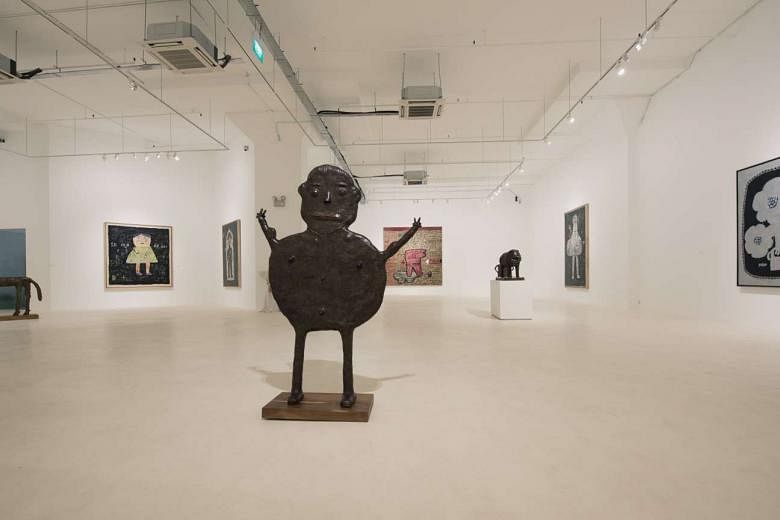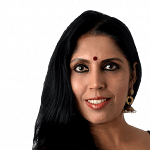At a time when art galleries are downsizing or shutting down, Singapore's Gajah Gallery is marking its 20th anniversary in a new space at Tanjong Pagar Distripark.
The 6,000 sq ft gallery at Artspace@Helutrans, with its 5.5m-high ceiling, allows it to display large sculptures, installations and paintings. The space is more than twice that of its previous premises in Hill Street.
Gallery director Jasdeep Sandhu, 49, says the new gallery, located on the third floor, has "great potential". The Tanjong Pagar Distripark next to the port offers "something rarely seen in Singapore".
Set against the backdrop of Singapore's container port, the warehouse complex seemed an unlikely place for an art gallery when prominent regional gallerist Valentine Willie set up shop there in 2008.
Even though his gallery has since shut down, Artspace@Helutrans has routinely been in the news because of several cutting-edge contemporary art pop-up shows presented by Mr Willie and others such as prominent Japanese gallerist Ikkan Sanada of Ikkan Art gallery and Malaysian gallerist Richard Koh of Richard Koh Fine Art.
Since art is no longer confined to a traditional painting hung on a wall, the open layout lends itself easily to bigger artworks and large- scale installations.
-
VIEW IT /THE GARDEN IN EDEN BY YUNIZAR
-
WHEN:Till March9. 11am to7pm (Monday to Friday), noon to6pm (Saturday and Sunday).
WHERE: Gajah Gallery, 03-04 Tanjong Pagar Distripark,39 KeppelRoad
ADMISSION: Free
INFO: Call 6737-4202 or go to www.gajahgallery.com
When The Straits Times visited Gajah's sprawling space last week, it was presenting Indonesian artist Yunizar's solo show, The Garden In Eden. While the artist's work has been exhibited several times here, his large canvases and sculptures breathe more easily in the wide expanse of space.
Mr Sandhu, a Singaporean, says that for his 20th anniversary celebrations, he has several special shows featuring large-scale works such as Yunizar's.
In April, there is the first part of its Anniversary Show. The group exhibition features several of the gallery's key artists, including Bali-based American artist Ashley Bickerton, Malaysian artist Ahmad Zakii Anwar and Singapore's Jason Lim and sculptor Kumari Nahappan.
This will be followed by a solo exhibition by Indonesian artist Ugo Untoro.
October will round off the big celebrations with part two of the Anniversary Show, featuring works by Indian master Jogen Chowdhury, prominent contemporary Indonesian artists Jumaldi Alfi, Handiwirman Saputra and Singapore's prominent installation artist Suzann Victor and the late ink painter Chua Ek Kay.
While Gajah's work promoting and positioning South-east Asian art has been extensively documented, one little-known fact is that Mr Sandhu was the first to bring "the master of the unbroken line", Jogen Chowdhury, to Singapore. The Indian painter is called that because his work is often defined by characters and settings created through the use of unbroken lines.
Mr Sandhu says: "It started with an accidental trip to Shantiniketan."
This is the university in West Bengal that Nobel laureate Rabindranath Tagore founded. It is known globally for its arts faculty. Mr Sandhu took one of his early trips to India's key arts centre to get an education himself.
"It was my first foray into art. While I had heard of the Indian art movement, I did not fully understand its significance."
That trip in the mid-1990s gave him "a lot of grounding and the inspiration to carry on", he says.
He decided to focus on South-east Asian art as there were several established dealers handling Indian art, even at that time.
Another lesser known fact is that he is a trained lawyer whose first job was in a bonsai shop. Smiling at the recollection, he says, his love for art could have started there.
He says: "I finished my law degree and after working in a bonsai shop, got a temporary job in an art gallery. At first, I felt it was a strange world. Slowly, I started thinking it is a nice world and wanted to be a part of it."
He opened his gallery in 1996 at Monk's Hill, to promote South-east Asian contemporary art with a focus on Indonesian contemporary art.
Over the years, he says, the gallery has focused on presenting exhibitions, but also building an archive and supporting academic contributions to Indonesian art and history.
Some of the exhibitions have travelled too. For instance, Intersections: Latin American and Southeast Asian Contemporary Art went to Havana, Cuba in 2014.
Twenty years on, the bachelor not only has a much larger gallery at Artspace@Helutrans but also an art facility and exhibition space in Indonesia's arts capital - Yogyakarta.
This is a project he is proud of. The art institute, Yogya Art Lab, which he started three years ago, is an experimental platform that allows prominent and emerging artists to come together to produce works across various mediums. They work with paper, sculpture and on digital platforms. Having worked with artists from Indonesia for the last 20 years, Mr Sandhu felt that while there are many artists in the country, the process of art- making remains "under-funded" and could do with greater support.
With proper facilities in place, artists could have the freedom to create works that are much larger in scale and to match international standards.
He calls the journey there "an organic, collaborative process with the artists and the artisans". It was something he stumbled into without much initial thought.
Working with established artists such as Yunizar and Ashley Bickerton has resulted in some impressive artworks, which will be presented here as part of the anniversary shows.
Despite the looming economic uncertainties, he is optimistic about the long-term future of art.
"I have lived through many economic cycles," he says. "Yes, things get tough, but the value of a good artwork can only appreciate. Sometimes, it can have the opposite effect. I have seen collectors turn to art when property and financial sectors are not offering the returns they expect."
His only regret has been parting with some pieces he could have kept. "I could have sold a lot less art and been a very rich man."



